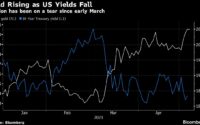$1.7 Trillion Omnibus Pitches House Republicans Vs Senate RINOs
By Philip Marey, Senior US Strategist at Rabobank
Last Man Standing
The S&P500 gained 0.10% yesterday, after four sessions of decline. Energy and materials stocks rose, but consumer staples and consumer discretionary fell. Meanwhile, the yen held on to its gains against the US dollar, euro and sterling, after the surprise move by the Bank of Japan.
Yesterday, US housing starts deteriorated less than expected with only a 0.5% decline in November, after a 2.1% fall in October. In contrast, building permits plummeted by 11.2% after a 3.3% decrease a month earlier. Since building permits are forward-looking, this suggests that homebuilding activity still has some rough patches ahead. Although mortgage rates may have peaked this year, they are still very high and the Fed does not anticipate cutting policy rates before 2024.
Earlier on Tuesday, US lawmakers unveiled a spending bill for fiscal year 2023, which started on October 1, 2022. Rejection of this proposal would lead to a partial government shutdown after December 23 (Friday). The bipartisan bill contains $858 billion in military spending and $772.5 billion in nondefense discretionary spending. This includes an additional $44.9 billion to support Ukraine’s military effort, and an update of the 1887 Electoral Count Act to try to make it harder to block the certification of a presidential election, which the lawmakers think would avoid a repeat of the January 6, 2021, insurrection. The Senate is expected to vote first, followed by the House of Representatives. The interim funding bill expires after December 23.
Note that the old Congress is still in session, with Democratic majorities in both chambers. The Republican takeover of the House of Representatives – the consequence of the midterm elections held in November – does not take place until January. The Republican leadership in the House, including minority Leader McCarthy, urges their rank-and-file to oppose the proposed package in order to push the negotiations into 2023, when they become the majority party in the House. However, the Republicans cannot block the bill on their own, as only a simple majority is needed to pass the bill in the House.
In contrast, in the Senate a majority of 60 votes is needed, which requires some Republicans to cross the isle. The Republican leadership in the Senate is calling for passage of the bill because they limited non-defense spending on domestic programs.
It remains to be seen whether there are enough Republican senators willing to delay the bill beyond December 23, because that would set off a partial government shutdown. Adoption of this week’s spending bill will avert a government shutdown next week, however, as we explained in Midterm implications, the changing balance of power in Washington DC is likely to lead to a return of fiscal standoffs between Democrats and Republicans in 2023.
Day Ahead
Today, we get US existing home sales and consumer confidence. As we discussed yesterday, the Fed’s tightening has been affecting the housing sector for most of this year, but consumer spending has remained solid due to the strong labor market and the personal savings from the generous COVID-relief programs by the Trump and Biden administrations. Therefore, after a technical recession in 2022, we are still waiting for an NBER-approved recession in 2023.
This explains why the Bloomberg consensus expectation is for another decline in existing home sales in November, by 5.2% after a 5.9% fall in October. Existing home sales peaked at 6.49 million in January 2022, and has been falling ever since. In October, existing home sales reached 4.43 million. The consensus expectation for November of 4.20 million would get us even closer to the COVID-era low of 4.07, recorded in million May 2020.
Meanwhile, consumer confidence, as measured by the Conference Board, has been on a downward trend since it peaked at 128.90 in June 2021 and now at 100.2 it is around levels seen during the pandemic, when the index hovered between 85.70 and 101.4. Despite their foul mood, consumers have been able to continue spending, showing 1.7% growth in Q3 (at an annualized rate). Meanwhile, gross private domestic investment contracted by 9.1% in Q3, due to the severe decline in residential investment. Once business investment heads south, which is only a matter of time, with high interest rates and possible expectations of a recession, the US consumer may be the last person standing before the economy falls into (an NBER-approved) recession. The labor market remains tight and there are still large savings from the COVID-era, but the latter are likely to be depleted during the course of 2023 and the Fed will keep interest rates high until there is sufficient slack in the labor market to ease wage and price pressures. This means that sooner or later, our forecast is the second half of 2023, consumers will surrender and the economy will slip into a recession.
Loading…
[ad_2]
Source link


